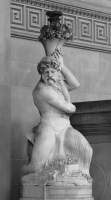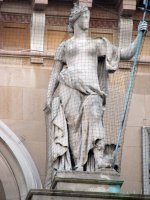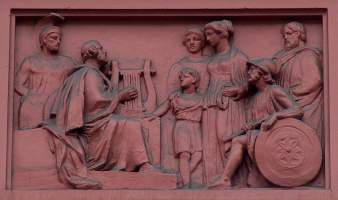William Grinsell Nicholl (1796-1871)
Merman by Nicholl, St George's Hall, Liverpool.
The sculptor WG Nicholl's best known works are perhaps the Fitzwilliam Museum pediment, in Cambridge, and for his four giant lions in stone outside St George's Hall, Liverpool - few would know he was the artist who carved them.
He was born in 1796, and in 1822 became a student at the Royal Academy, exhibiting there from that year intermittently through until 1861, showing 7 works, including his large statue of Hercules Agonistes and an Apollo, a model of the Fitzwilliam pediment (noting it was after the design of CL Eastlake RA), and most intriguingly, an Ideal head of Australia seated on the Platycerium Grande, a plant indigenous to the tropical coast of New South Wales. He set up his studio in London, in Grafton Street. George Basevi, the architect employed him (including on the Fitzwilliam), and later, he worked for C. R. Cockerell, but for a considerable period of his life he does not seem to have been that prosperous or successful.
His architectural sculpture includes as well as the Fitzwilliam, the panels on the Oxford and Cambridge Club, Pall Mall (not to his own design, but to that of the father of the architect Robert Smirke), carvings for the Taylorian Institute, Oxford, and pedimental sculpture for St George's Hall, Liverpool, later removed, and, I think, destroyed.
Taylorian Institute figure by Nicholl.
Still intact by St George's Hall, are four giant lions by Nicholl, and mermaid and merman lampholders. On the former India Office (Foreign and Commonwealth Office) in Whitehall, he is responsible for the statues of Cornwallis, and Clive of India.
He made at least a few church monuments, including one to J. Hippisley, d.1825, in Temple Church, a glum bust of John Law, Archdeacon of Rochester, in Chatham Parish Church, and a monument to Elizabeth Morley in Walthamstow Parish Church. We may also mention a bust of P. Rundell in the V&A collection, which I have not seen on display but is illustrated on the V&A website - it shows a rather unsympathetic rendering of what could easily be a posthumous portrait, or nearly so.
From the works I have seen, it is not easy to characterise Nicholl s work. The Liverpool lions are solid, grand. The mermaid and mermen lampholders have a solid mass to them also, and are perhaps his most enjoyable works - they are of the Triton, twin-tailed type (see the page on Mermaids). The Taylorian Institute has panels showing heraldic winged lions in high relief, too formalised to show much individuality of the artist. There are four statues on the front of that building, very worn, which I am not certain are by Nicholl, but are comparable to his work elsewhere. The panels on the Oxford and Cambridge club show short, stocky figures, simply draped and well composed for their setting. One characteristic, along with the chunkiness of his figures, would seem to be a rather hooded look to their eyes.
Panel from the Oxford and Cambridge Club.


